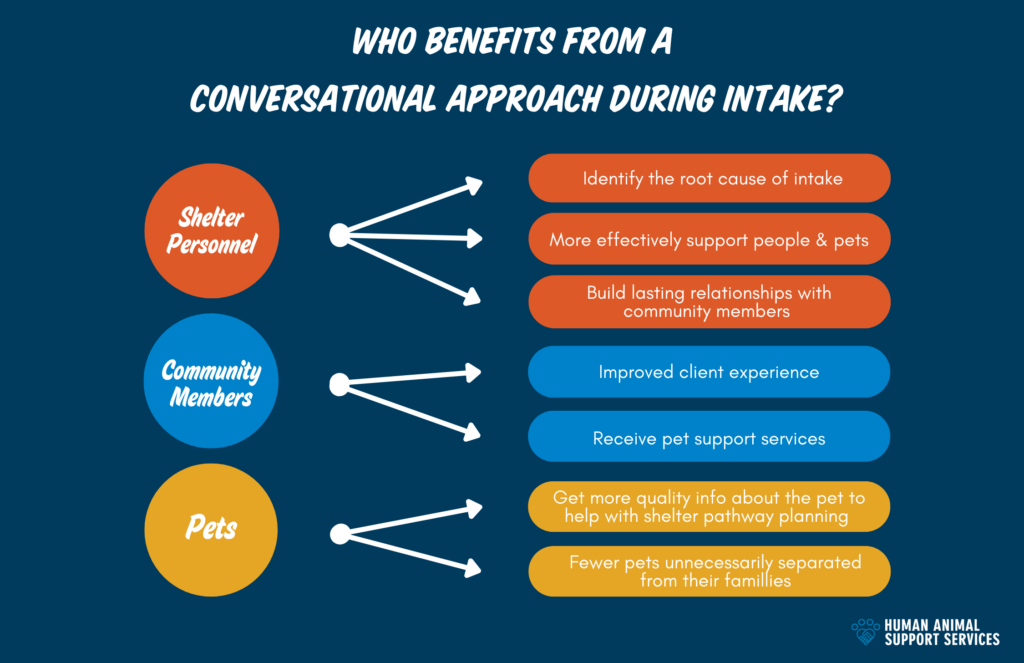Build trust with the public seeking pet support services
Imagine this. You’re going through the toughest period in your life. Maybe you lost your job, and your home, and now you have nowhere to go with your pet. On top of it, you’re struggling to provide basic care for both of you. You’ve tried everything, and you realize that the only way out of the situation is to focus on providing for yourself first, to get back on your feet. You take your beloved pet to the local animal shelter hoping that someone can help them. You’re greeted by shelter staff who offer to take the pet in, you sign some paperwork, and off you go. You wonder, “Do they have everything they need to take care of my pet? Wait, they didn’t ask about what her likes and dislikes were and I didn’t get a good opportunity to tell them that she often has a sensitive stomach!” You hope with all your heart she gets what she needs to make it to her next home.
Unfortunately, this scenario is a very real reality for families across the nation. According to these reports, layoffs soared 98% in 2023 compared to that of 2022 and eviction filings are 50% higher in some cities compared to pre-pandemic numbers.
But did this scenario support both the pet and person? Did we help them in the next steps of their journey? Were there any interventions that could have helped keep this family together? We’ll never know, because we didn’t ask. This is what we mean when we say animal services could use a little more individualized support.
We will never learn about the root causes of pets coming into shelters if we don’t tap into the one advocate the pet already has, the owner, when you have their undivided attention. It’s easy to take a story at face value. If someone shares that their pet has a behavior challenge, without further questioning we might think they aren’t willing to work with the pet’s challenges. Do they know how to address the behavior challenge? Do they have access to a qualified trainer or training resources?
Through a deeper conversation, we might find that the actual root cause of their challenges is a lack of access to behavior resources, not that the individual didn’t care to address or work with the problem. There is almost always a more complex story just beneath the surface if you take the time to dig a little deeper.
So how does the animal welfare industry move the needle from a transactional to conversational approach that prioritizes both the person AND the pet’s needs?
Start simply:
- Ask, “What brings you here today?” Give them space to tell their story before making any assumptions or judgments.
- Ask detailed follow-up questions. This will help you get to the root cause and allow you the opportunity to offer direct pet or human support or to refer to external services.
Explore these topics to help you envision a meaningful conversational approach:
- Lead conversations with empathy
- Approach with non-judgment
- Approach with cultural sensitivity
- Ask open-ended questions
- Practice active listening and reflection techniques
- Observe and be mindful of body language
- Trauma-informed Care
Imagine the opening scenario again to include a holistic, person–oriented interaction.
What if we had asked: What is the barrier to securing housing that would allow your pet to live with you?
In this case, it’s time. She needs time to find a housing option. In the meantime, she has reached out to friends and family and no one is able to temporarily house her pet.
A straightforward solution, like temporary care for her pet, might be just the intervention needed to maintain this family unit and support the human-animal bond. Without asking deeper questions, we can’t identify the root cause, and without root cause, it will be difficult to offer a supportive solution. Understanding is the best first step.
Consider these strategies to help you fully implement a conversational approach:
Efficient Intake Processes – Ensure you have a smooth intake process flow by streamlining to improve wait times for clients, staff focus, or overall efficiencies. Depending on what your process looks like currently, having a conversational interview/process, doesn’t always equate to longer wait times but it does mean having higher-quality conversations. Minimizing distractions and improving efficiencies sets the stage for success.
- Reduce interruptions – For organizations with high-volume phone calls, consider integrating a text line or remote phone call dispatch system to reduce continuous ringing.
- Manage wait times – Utilize a digital platform for appointment scheduling and/or managing a virtual waitlist.
Staff Training – This is a learning process that requires more than a single staff meeting or training video. The intake team will need ongoing managerial support and education to refine their skills and build confidence.
- Modeling – What better way to learn than to watch a seasoned professional with good people skills navigate difficult conversations with nuance and empathy?
- Continued coaching and accountability – Change is hard, especially when you’re honing a new skill. Management presence is critical to help staff keep the end goal top-of-mind and to ensure we don’t fall back into old habits, especially when things get hectic.
- Use this sample training video to get started.

Now imagine this.
You’re going through the toughest period in your life. You lost your job and your home, and now you have nowhere to go with your pet and you’re struggling to provide basic care for both of you. You talk to your local animal shelter and they offer your pet a safety net of being housed in a temporary foster home. This gives you time to get back on your feet, find new housing, and you’re able to welcome your pet back home, just like what happened with Jericho at our pilot shelter Pima Animal Care Center.









